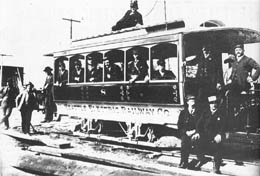On March 30, 1889, Frank Osgood (1852-1934) tests Seattle's first electric streetcars on his 2nd Avenue line. Addie Burns, an investor in the Seattle Electric Railway and Power Company, is the system's first passenger. Osgood retires all horse-drawn "hayburners" by April 5, 1889, making Seattle the first West Coast city to offer a fully electric streetcar service.
Osgood had built his original horse-drawn line in 1884. Three years later, Frank J. Sprague demonstrated the first electric streetcar in Richmond, Virginia. Osgood joined forces with investors Addie Burns, Edward C. Kilbourne (1856-1959), L. H. Griffith, Franz Theodore Blunck (1841-1918), and others to convert his line to electric traction.
Watches Stopped? Pedestrians Zapped?
The use of electricity caused some public apprehension. Some feared that the newfangled streetcars would magnetize watches or zap pedestrians with bolts of lightning. Skeptics doubted their ability to master Seattle's steep grades.
But doubters and naysayers were proved wrong and construction of electric street railways became something of a fad in Seattle. By 1892, Seattle was served by 48 miles of streetcar lines and 22 miles of cable car lines. This trackage doubled during the decade, while the national Stone & Webster utility cartel quietly bought up each and every one of Seattle 22 separate streetcar lines.
Stone & Webster's Seattle Electric Railway Company won a 40-year franchise to operate the system in 1900, but lost money on the mandated nickel fares. The cartel sold the lines to the city government in 1918. Beginning in 1940, the city tore up its street railways and replaced streetcars with buses and trackless trolleys.

